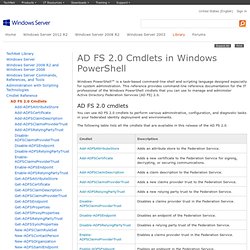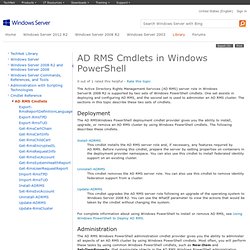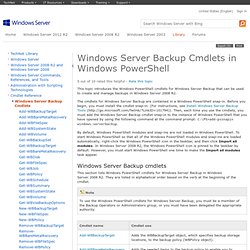

Active Directory Cmdlets in Windows PowerShell. Windows PowerShell™ is a task-based command-line shell and scripting language designed especially for system administration.

This reference topic for the information technology (IT) professional introduces the 76 Windows PowerShell cmdlets that you can use to manage and administer the Active Directory® directory service and Active Directory Domain Services (AD DS). What does the Active Directory module do? The Active Directory module for Windows PowerShell in Windows Server 2008 R2 is a Windows PowerShell module (named Active Directory) that consolidates a group of cmdlets.
You can use these cmdlets to manage your Active Directory domains, Active Directory Lightweight Directory Services (AD LDS) configuration sets, and Active Directory Database Mounting Tool instances in a single, self-contained package. Active Directory module provider cd dir remove . .. AD FS 2.0 Cmdlets in Windows PowerShell. Windows PowerShell™ is a task-based command-line shell and scripting language designed especially for system administration.

This reference provides command-line reference documentation for the IT professional of the Windows PowerShell cmdlets that you can use to manage and administer Active Directory Federation Services (AD FS) 2.0. AD FS 2.0 cmdlets You can use AD FS 2.0 cmdlets to perform various administrative, configuration, and diagnostic tasks in your federated identity deployment and environments. The following table lists all the cmdlets that are available in this release of the AD FS 2.0. For more information about—or for the syntax for—any of the AD FS 2.0 cmdlets, use the Get-Help <cmdlet name> cmdlet, where <cmdlet name> is the name of the cmdlet that you want to research. Get-Help <cmdlet name> -Detailed Get-Help <cmdlet name> -Full Get-Help <cmdlet name> -Detailed Get-Help <cmdlet name> -Examples More information.
AD RMS Cmdlets in Windows PowerShell. The Active Directory Rights Management Services (AD RMS) server role in Windows Server® 2008 R2 is supported by two sets of Windows PowerShell cmdlets.

One set assists in deploying and configuring AD RMS, and the second set is used to administer an AD RMS cluster. The sections in this topic describe these two sets of cmdlets. Deployment The AD RMSWindows PowerShell deployment cmdlet provider gives you the ability to install, upgrade, or remove an AD RMS cluster by using Windows PowerShell cmdlets. The following describes these cmdlets. Install-ADRMS This cmdlet installs the AD RMS server role and, if necessary, any features required by AD RMS. Uninstall-ADRMS This cmdlet removes the AD RMS server role. Update-ADRMS This cmdlet upgrades the AD RMS server role following an upgrade of the operating system to Windows Server 2008 R2. For complete information about using Windows PowerShell to install or remove AD RMS, see Using Windows PowerShell to Deploy AD RMS.
Administration. AppLocker Cmdlets in Windows PowerShell. This reference topic for the IT professional introduces the five Windows PowerShell cmdlets that can be used to help manage AppLocker policies in Windows Server 2008 R2 and Windows 7.

The AppLocker Windows PowerShell cmdlets are designed to streamline the administration of AppLocker policy. They can be used to help author, test, maintain, and troubleshoot an AppLocker policy. The cmdlets are intended to be used in conjunction with the AppLocker user interface that is accessed through the Microsoft Management Console (MMC) snap-in extension to the Local Security Policy snap-in and Group Policy Management Console. Best Practice Analyzer Cmdlets in Windows PowerShell. Background Intelligent Transfer Service (BITS) Cmdlets. Failover Cluster Cmdlets in Windows PowerShell. Network Load Balancing cmdlets in Windows PowerShell. Web Server (IIS) Administration Cmdlets in Windows PowerShell. The Web Server Administration module for Windows PowerShell includes the Internet Information Services (IIS) cmdlets that let you manage the configuration and run-time data of IIS.

It implements a namespace hierarchy containing Application Pools, Web sites, Web applications and virtual directories. The IIS module implements one virtual drive named IIS. The root virtual folders are AppPools and Sites. Within the AppPools folder, run-time data, such as the currently running worker processes, application domains, and requests can be found. The Sites folder contains Web site folders, as well as applications and virtual directories. By default, Windows PowerShell modules and snap-ins are not loaded in Windows PowerShell.
You can manually add the IIS Module to the instance of Windows PowerShell that you have opened by using the following command at the command prompt: C:\PS>add-pssnapin WebAdministration. Windows Server Backup Cmdlets in Windows PowerShell. This topic introduces the Windows PowerShell cmdlets for Windows Server Backup that can be used to create and manage backups in Windows Server 2008 R2.

The cmdlets for Windows Server Backup are contained in a Windows PowerShell snap-in. Before you begin, you must install the cmdlet snap-in. Cmdlet Reference for Windows Server 2008 R2. Group Policy Cmdlets in Windows PowerShell. The Windows PowerShell command-line and scripting language can be used to automate many Group Policy tasks, including configuring registry-based policy settings and various Group Policy Management Console (GPMC) tasks.

To help you perform these tasks, the Group Policy module for Windows PowerShell provides the cmdlets covered in this section. You can use these Group Policy cmdlets to perform the following tasks for domain-based Group Policy objects (GPOs): Maintain GPOs: GPO creation, removal, backup, reporting, and import. Associate GPOs with Active Directory Directory Services (AD DS) containers: Group Policy link creation, update, and removal.
Set inheritance and permissions on AD DS organizational units (OUs) and domains. Server Manager Cmdlets in Windows PowerShell. Windows Server Migration Tools Cmdlets in Windows PowerShell.